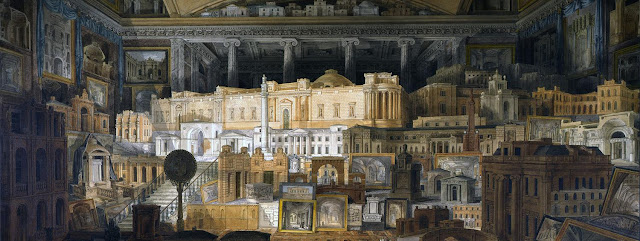 |
| The Bowes Museum |
Caroline is currently taking part in a project at the Bowes Museum. #Untitled 10 involves ten different practitioners making new work that explores the museum's collection, the people and the architecture. One of the key aims of this commission is for the ten participants to document and share their creative journey and to engage the public in the processes, materials and techniques that artists, designers and craft practitioners use when making work. For this commission Caroline is researching the Bowes Museum building and architecture and will explore these these through her practice in the paper arts and design for performance and film. The project does not need to reach a final completed outcome, although there will be an exhibition of the work made, so there is more scope for experimentation than would usually occur on paid commissions.
 |
View from the grand terrace of the parterre at the Bowes Museum
|
The Bowes Museum opened in 1892 and was designed by a French architect,
Jules Pellechet, in the ‘petit Louvre’ style. The palatial style of the chateau design was typical of museums in France but it is a strange and unexpected sight in the English rural landscape. Entering through the iron gates at the museum entrance is to feel transported to another time and place. The theatricality of the interior and exterior spaces, the scale of the architecture and the museum collection is a rich source of inspiration. The first encounter with the museum architecture and exterior spaces brought to mind the French film "Last Year at Marienbad" that used the grand settings of a former palace to play with ideas of narrative, space, time and memory to create a dream state.
 |
| Film still from "Last Year at Marienbad," directed by Alain Resnais |
A second reference point is the work of Wes Anderson who creates detailed parallel worlds within his films. Extensive research into art and design from different eras are used to create costume and production designs that are a collage composed of different influences. The juxtaposition of contrasting elements creates a heightened sense of reality. In the film "The Grand Budapest Hotel" the palatial architecture of the hotel is remotely situated on top of a hill surrounded by trees with a funicular railway between the village and the hotel.
 |
| Film still from “The Grand Budapest Hotel,” directed by Wes Anderson |
For “The Grand Budapest Hotel,” Wes Anderson and his team decided to use miniature models to represent the hotel exteriors. The idea of creating miniature theatrical models and objects is an approach Caroline is planning to adopt within this commission. This will enable experimentation and prototyping crafted paper textiles that will draw upon the architecture of the Bowes Museum. There is also the scope to animate these objects and explore filmmaking on a small scale.






Comments
Post a Comment